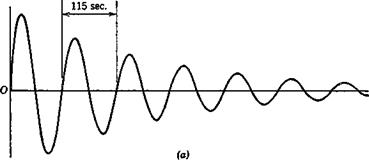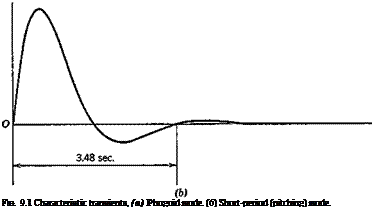EIGENVALUES
Mode 1: 1 = -.3065 X lO"4 ± .573 X 10~3 *
Mode 2:1= -.1161 X 10-1 ± .1891 X 10-4
The corresponding periods and damping times are given in Table 9.1. We note that the phugoid mode is of long period (about 2 min) and lightly damped, whereas the short-period mode is quite rapid and very heavily damped. The characteristic transients of these two modes are shown in Pig. 9.1.
f Prepared by Dr. P. C. Hughes. It is perhaps indicative of the times that most of the digital computation needed for this and the following examples was performed, using these subroutines, by a high-school student, David Alexander Etkin.
Table 9.1
|
Mode |
Name |
Period (sec) |
fhalf (sec) |
-^half (cycles) |
|
1 |
Phugoid® |
115 |
237 |
2.06 |
|
2 |
Short-period |
3.48 |
.626 |
.18 |
 |
 |
a The phugoid mode was first described by Lanchester (ref. 1.1), who also named it. The name comes from the Greek root for flee as in fugitive. Actually Lanchester wanted the root for fly. Appropriate or not, the word phugoid has become established in aeronautical jargon.











